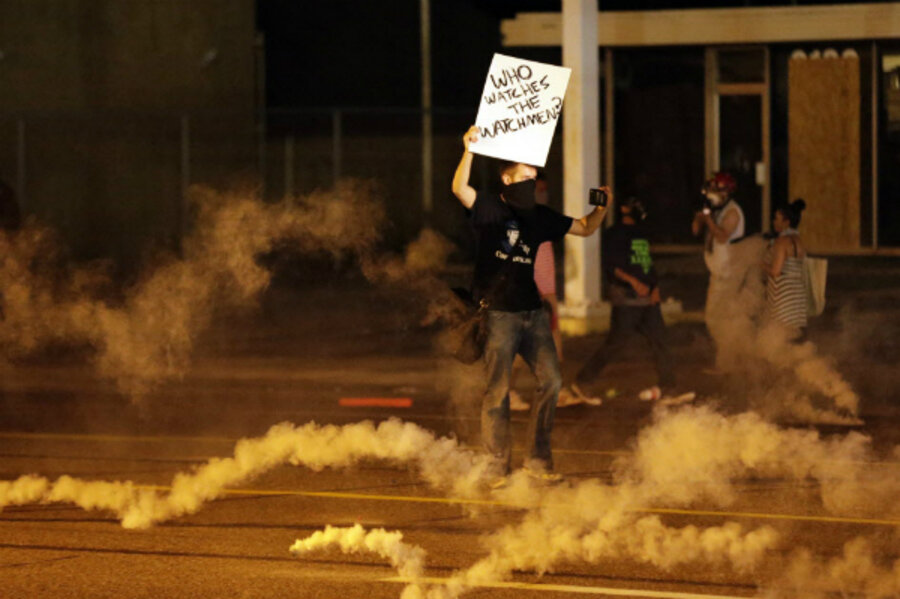Mike Brown protests: why the looting, tear gas got worse
Loading...
Gov. Jay Nixon (D) of Missouri signed an order deploying the National Guard to the racially tense St. Louis suburb of Ferguson early Monday, after a night of intensified violence, during which protesters fired guns and threw makeshift explosives at police. [Editor's note: The original version used a term in place of "makeshift explosives" that did not accurately describe what happened.]
This move came the day after a private autopsy commissioned by the family of slain teen Mike Brown indicated that he was shot at least six times, twice in the head – probably not from close range and not in the back, according to the medical examiner.
“Tonight, a day of hope, prayers, and peaceful protests was marred by the violent criminal acts of an organized and growing number of individuals, many from outside the community and state, whose actions are putting the residents and businesses of Ferguson at risk,” Governor Nixon said, in the statement accompanying his order.
Late Sunday night saw both the most intense vandalism and looting yet – as well as the most powerful show of force by police to date.
The trouble started at about 9 p.m. on West Florissant Avenue, where Mr. Brown was gunned down on Aug. 9 after an altercation with officer Darren Wilson. There, hundreds of police officers with riot gear emerged to disperse a crowd of protesters, using rubber bullets, beanbag projectiles, and tear gas.
While protesters condemned the police, saying the move to break up the crowd was unprovoked, the Missouri State Highway Patrol said the protesters had attempted to overrun a command post in a shopping center parking lot. Police say protesters fired at least 30 gunshots and threw Molotov cocktails.
“We ordered them back. We ordered them back again,” Highway Patrol Cpl. Justin Wheetley told Reuters. “After several attempts, we utilized smoke to disperse the crowd.”
In the ensuing turmoil, intense looting erupted as did shootings and other acts of violence.
Police reports note that McDonald’s employees were forced to lock themselves in a closet after being “overrun” by protesters. The demonstrators also attempted to block off a city street with cinder blocks.
According to Capt. Ron Johnson, who was put in charge of the police response to the protests on Aug. 14, this new spate of violence appeared to be “premeditated” and “coordinated,” rather than spontaneous.
The recent developments in Ferguson represent the latest move in a dramatic backslide for the public safety situation in the suburb, where violence had nearly ceased just a few days ago, following the appointment of Captain Johnson, a Ferguson resident.
When Mr. Wilson shot Brown nine days ago in the largely black city, looting and riots soon erupted, with much of the public frustration directed at the largely white police department and local government. Critics said the local Ferguson police, which counts only three black officers among its ranks, exacerbated these tensions by responding in a heavily militarized fashion – with armored vehicles, automatic weapons, military fatigues, and other equipment typically found in a war zone.
In response, Nixon put Johnson, who is black, and the Highway Patrol in charge of containing the protests – pushing local and county police aside. Johnson then jettisoned the military tactics and walked hand in hand with protesters, adopting a nonconfrontational, community-based strategy that appeared to work, at least before violence progressively flared up again in the days that followed.
On Friday – when officials made public the name of the officer in the shooting – Ferguson Police Chief Thomas Jackson also released security camera footage that police said showed Brown strong-arming the clerk of a convenience store after shoplifting a box cigars minutes before his fatal confrontation with Wilson. The disclosure drew fire from many in the community, who said police were trying to besmirch the victim.
On Sunday, Ferguson residents were again provoked by the results of the independent autopsy commissioned by the Brown family and conducted by Dr. Michael Baden, a former chief medical examiner for New York City.
Dr. Baden noted that Brown's body had no signs of gunshot residue, indicating that Wilson did not appear to have fired from close range. Baden noted that he would need to search the clothes of Brown for residue to make a conclusive determination on that matter, however, and that his report was not meant as a determination of guilt or innocence for either party.
Still, he indicated, local officials could have added transparency to the process by releasing information they obtained in their autopsy several days earlier.
“People have been asking: How many times was he shot? This information could have been released on Day 1,” Baden told The New York Times. “They don’t do that, even as feelings built up among the citizenry that there was a coverup. We are hoping to alleviate that.”
Another autopsy will be conducted by the US Department of Justice, Attorney General Eric Holder announced Sunday, citing the “extraordinary circumstances” of the shooting.
• This report includes material from Reuters and The Associated Press.





